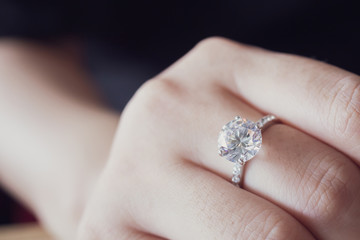What is a Round Cut Lab Diamond?
The round cut lab diamond is both beautiful and timeless. Because of its perfectly symmetrical nature, the round lab diamond has been the most popular cut, by a wide margin, of every decade for as long as lab diamond rings have existed. Including the culet, the Round Brilliant Cut is round visually and has 58 facets and provides excellent white light reflection, or brilliance. Round Brilliant Cuts have a classic, timeless appearance and are frequently used in engagement rings, necklaces, and other fine jewellery pieces.
 Marcel Tolkowsky sparked interest in the Round Cut Lab Diamond in 1919 when he published "Lab Diamond Design: A Study of the Reflection and Refraction of Light in Lab Diamond," which highlighted the ideal cut aspects of a Round Brilliant. The Round Cut has remained the most popular lab diamond cut since Tolkowsky's influence.
Marcel Tolkowsky sparked interest in the Round Cut Lab Diamond in 1919 when he published "Lab Diamond Design: A Study of the Reflection and Refraction of Light in Lab Diamond," which highlighted the ideal cut aspects of a Round Brilliant. The Round Cut has remained the most popular lab diamond cut since Tolkowsky's influence.
The Old European cut was a popular lab diamond choice during the Victorian, Edwardian, and Art Deco eras. Lab Diamond cutting techniques became more refined as knowledge and technology advanced. The cut design evolved to include larger tables, smaller culets, and longer, leaner facets. Whereas Old Europeans were cut for colour, Round Brilliants are cut for brilliance.
The main distinction between the Old European and Round Cut is that the Old European retains facets with triangular blocks, whereas the Round Brilliant has thinner facets. Some customers appreciate the Old European's vintage style and personality, but the majority prefer the Round Cut's brilliance.
In the lab diamond industry, the term "Round Cut" is used, but this refers to the shape of the lab diamond. There is no distinction between a Round Cut and a Round Shaped lab diamond, so when someone mentions a Round Cut, Round Brilliant Cut, or Round Shaped lab diamond, they are all referring to the same thing.
Why Are Round Cut Lab Diamonds So Popular?
The round cut lab diamond is the most popular lab diamond shape, accounting for more than two-thirds of all lab diamonds sold across the world. Round cut lab diamonds are so popular because of its beauty, brilliance, fire, versatility and timeless appearance.
Round cut lab diamonds have 58 facets that reflect light back to your eyes. Lab Diamond cutters have been perfecting the process of cutting round lab diamonds for over a century. The end result is stunning gemstones with a classic appearance.
A lab diamond's brilliance is what makes it sparkle. It is the amount of white light reflected off the lab diamond's table and into your eyes. A round lab diamond's ideal cut characteristics provide more brilliance than any other shape.
The amount of coloured light dispersed by a lab diamond is referred to as its fire. This coloured reflection adds character and beauty to a lab diamond. A round lab diamond with an exceptional cut displays a tremendous amount of fire.
Because of its classic design, the round brilliant complements a wide range of styles, from modern round cut lab diamond rings to vintage engagement rings. round lab diamonds have been popular for centuries. A round cut ring, with its beautiful facets and elegance, is a timeless choice that will be treasured and passed down for generations.
What is the most important quality of a round cut lab diamond?
The cut quality of a lab diamond has the greatest influence on round cut lab diamond's beauty of all the characteristics. It refers to how well-proportioned and visually appealing a lab diamond is. The proportions of a lab diamond's cut affect its ability to reflect light and provide brilliance.
The most important of the four Cs of lab diamond quality is cut. While you can settle for a lower Clarity or Color grade, or find a beautiful lab diamond at a low Carat weight, you will rarely, if ever, find a passable lab diamond if you settle for a less-than-ideal Cut grade.
A poorly cut lab diamond will be dull or oddly proportioned, rendering all other qualities irrelevant. The GIA is a well-known and respected lab grading entity that issues lab diamond reports. While GIA grade is important, it is not the only factor to consider when determining Cut. Keep this in mind as you shop for lab diamonds, as approximately 55% of all GIA round lab diamonds listed on the internet are Excellent cuts. This indicates that there is a wide range of "excellence" within their grade level - ranging from truly stunning to mediocre.
To determine the cut quality of a lab diamond, make sure it is not cut too shallow or too deep. Incoming light strikes the pavilion at a low angle when a Round Brilliant is cut too shallow. The light then passes through the lab diamond and exits through the sides, without reflecting back to the eyes through the table. Because of the large amount of escaping light, the lab diamond lacks both brilliance and fire. If a lab diamond is cut too deeply, light will strike the pavilion at a sharper angle, causing it to reflect to another pavilion and exit through the bottom of the lab diamond rather than through the table. As a result, when a lab diamond is cut too deeply, it becomes dull rather than radiant.


